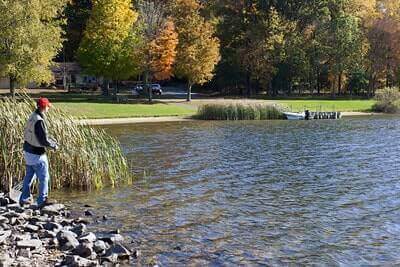Disclosure: We may earn commissions if you purchase products after clicking on a link from our site.
Do you want to learn how to catch more bass? Do you know that bass is one of the popular fishes in the waters? In this article, we discuss bass fishing tips that you can implement on your fishing trips to catch more bass like the pros.
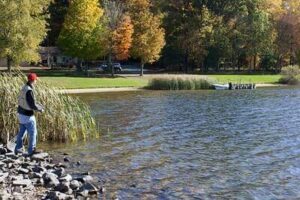
Table of Contents
- 1 How To Catch Bass
- 2 Bass Fishing Tackle
- 3 How To Catch Bass In A Lake
- 4 Bass Fishing Rigs
- 5 How To Catch Bass From Shore
- 6 How To Catch Bass With Lures
- 7 How To Catch Bass In A Pond
- 8 How To Catch Bass In Summer
- 9 How To Catch Bass In Fall
- 10 How To Catch Bass In Winter
- 11 How To Catch Bass In Spring
- 12 Bass Fishing Tips
- 13 Types of Bass
- 14 Best Bass Lures
- 15 Best Live Bait For Bass
- 16 The Bottom Line
How To Catch Bass
1. Stillwater Fishing
Stillwater fishing is one fishing method that anglers use to catch bass. It is ideal for beginners as well as experienced anglers. When still fishing, drop your bait into the water and just wait for the fish to strike. When you get a strike, control the line and quickly reel in the fish.
2. Casting
Casting can also be used to catch bass. You can cast from a boat or from the shore. When casting for fish, try casting at different areas and cast at a long distance to find the areas the fish is holding out.
3. Drift Fishing
You can fish for bass by drift fishing. When drift fishing, slowly move your boat over different habitats and let your bait move slowly in the water. Drift fishing covers a lot of areas and can be very effective as you can also catch a variety of fish.
4. Fly Fishing
Fly fishing is another fishing method that can be used to catch bass. Catching bass using fly fishing will put your fly fishing skills to the utmost test but it will challenge you to work on your skills and it can prove to be rewarding.
Bass Fishing Tackle
A 7- foot medium action fishing rod with a medium soft tip will work for fishing for bass.
How To Catch Bass In A Lake
When you go fishing on a lake, spend a few minutes looking at the lake and studying it. Observe any signs of life. Listen for sounds from bullfrogs, and look out for shorebirds like herons or ducks. Watch for small fish like shad or bluegills working the surface. These activities will give you a good idea of where marine life is active in the lake.
Bass, like most species of fish, will be near structures to hide from predators and prey that they want to eat. When fishing for bass in a lake, look for any signs of structures. That will be the first area to target for bass.
Additionally, look for any areas of the lake that have shade. Overhanging tree branches that provide shade to any part of the lake will be a good area to target. Bass will go to those shady areas to escape the sun’s rays. Fallen trees, logs, broken piers, and docks are areas where bass may be located.
Look for pockets or corners of the lake that have some vegetation like lily pads, hydrilla, and hyacinth. Bass will move to those areas also to use it as cover when looking for baitfish. Visit the lake at different times of the day to observe the activities. Most fish are active early morning and late evening. Visit the lake during those times to observe the activities of fish and other marine life.
On overcast days and bad weather bass and other fish will be more comfortable coming out of their cover. if there are overcast days and cloudy conditions, make a trip to the lake to fish for bass.
If it’s early fall, you can fish at night for bass as they will be on the hunt for food to put on more weight before winter comes in. This will make them go for anything and you may be able to catch more bass.
A fish finder can also be used when fishing for bass on a lake. When there are not many visible structures, you can use a fish finder to help you quickly locate bass on a lake if you have a boat. Additionally, there are castable fish finders that you can launch from the shore if you don’t have a boat. You can also troll the lake to fish for bass.
Bass Fishing Rigs
1. Carolina Rig
The Carolina rig is one of the popular rigs anglers used when fishing for bass. It features a sinker or bullet weight on the line. What makes the Carolina rig very effective is that it mimics the movements of bass prey like worms or baitfish. When you pull the line with the weight or sinker, it produces movements that resemble the movements of baitfish that bass prey on. You will need a heavy sinker, about 3/4 egg sinker, a small swivel, and the lead. You will also need 2-3 large hooks.
2. Texas Rig
The Texas rig is also one of the widely used rigs when fishing for bass. It involves a 4-10 inch plastic worm, a worm hook, and a bullet weight. Hook the head of the worm while leaving the hook open to attach the body of the worm. Then roll up the worm and hide the hook with its head. Then attach the worm’s body to the hook horizontally and camouflage the entire setup.
3. Drop Shot Rig
The drop shot rig is a more complicated rig. It is a versatile rig that allows anglers to fish in shallow and deep waters. It requires a drop shot hook and weight, a low visibility line, and the bait.
To set up the drop shot, start with a regular Palomar knot to the drop shot hook. Then trim the excess line to be the length you need. If you will fish in deeper waters, then you should leave a tagline of about 4 inches on the end of the knot.
4. Alabama Rig
The Alabama rig is similar to the umbrella rig. It was introduced by an Alabam angler called Andy Poss. The Alabama rig is slightly different from the umbrella rig by the reduced number of the umbrella rig to 5 flexible wires that make it look like a shad head.
To set up the Alabama rig, after rigging the swimbaits on the jigheads, attach the jigheads to a clip on the wires’ end holding the rig together. Slightly open the wires to give the swimbaits space to swim independently of one another.
5. Ned Rig
The Ned rig is ideal when fishing for smallmouth bass or spotted bass. It involves a light fishing line, a spinning rod, and a reel. With the line and jig, the threading begins with the jighead and securely fix it and hold on to the plastic and tie the rig to the leader line.
You can use a 10-pound main line and a 6-pound leader line. A spinning rod with medium-light power and super-fast action will work. The spinning reel has to be robust as it carries the light braid and leader.
How To Catch Bass From Shore
When fishing from the shore, walk lightly and minimize the noise you make. Fish can pick up the noise and the vibrations of heavy footsteps. This will make their escape to their cover.
When fishing from the shore, also spend some time studying the water. look for areas with shade and vegetation that may serve as cover for bass. Look for pockets of the water where they may be hanging out waiting for baitfish. If you locate these areas, fish there for bass.
Additionally, look for any signs of structures. Fallen trees and logs, broken piers, and docks are all areas where bass will hang around. If you find these or other structures, fish around those areas as the structure may be bigger under the water than what meets the eye on the surface.
Also, pay attention to signs of marine life. Baitfish may be active in some areas of the water and that may indicate that bass are in that area preying on baitfish. If you see birds circling overhead, then it is a sign that baitfish are in that area. Anglers use topwater frogs early in the morning and late in the evening when bass will come out to feed on baitfish.
How To Catch Bass With Lures
When fishing for bass, you can use baits and lures. Anglers use lures such as skirted jigs, plastic worms, soft plastics, topwater frogs, and lipless crankbaits to fish for bass. Most of the time, anglers will use lures like soft plastics, crankbaits, plastic worms, and topwater frogs when casting for bass.
When there is a lot of activity close to the surface, like in the early morning or late evening, they will use topwater frogs to fish for bass. If bass is found deeper in the water column, jigs, such as skirted jigs, will be used. There are many different lures that work well in different situations when fishing for bass.
How To Catch Bass In A Pond
Fishing for bass in a pond a similar to fishing for bass in a lake. When you go to the pond, spend some time studying it for possible signs of life, pockets with shade, overhanging trees, vegetation, and structures that bass can use as cover for protection and to ambush baitfish.
Additionally, look for signs of life from baitfish at the surface to find out where fish and other marine life may be located in the pond. Walk lightly and with no noise if you come to the banks of the pond as fish can pick up the noise and vibrations. This will make them move further into the water and structure for protection.
Fallen trees, logs, broken-down piers, and docks are structures that will attract bass. If you see any poles or timber pointing out of the water, there could be more of it in the water. Target those areas and fish for bass.
How To Catch Bass In Summer
When fishing for bass in the summer, look for structures like points, drop-offs, ledges, and brush piles. Study the water and look for structures that the bass may be hanging near. They will be close to structures to conceal themselves from baitfish as well as protect themselves from predators.
Additionally, look for areas with shade from overhanging trees. These are prime areas that will attract bass as they seek cover from the sun. Boat docks, boathouses, and piers can also provide shade that will attract bass.
How To Catch Bass In Fall
During the fall, bass will be found in areas where creeks and other bodies of water dump into a lake. They will be in those areas preying on baitfish that are funneled. Ditches, offshore humps, bluff mounds, trenches, and rock edges are areas to target when fishing for bass in the fall. Most anglers use soft plastics when fishing for bass in the fall.
How To Catch Bass In Winter
When fishing for bass in the winter, anglers will downsize and use soft plastic worms, hair jigs, jerkbaits, curly tail grubs, and other lures and bait to fish for bass. If the water is clear water, you may want to use lures with colors.
How To Catch Bass In Spring
Bass spawns in the spring and will be in shallow waters usually over hard-bottomed bays. Look for these areas to target them. They will be more aggressive as they will be protecting their eggs from lizards, bluegills, and other predators.
Bass Fishing Tips
1. Find Where Bass Resides
Bass likes to reside in cover. This is the area with old and broken down structures like boat docks, wooden structures, big rocks, fallen trees, lily pads, thick vegetation, tree stumps, access points, creek channels, drop-offs, holes, drain pipes, etc. Bass uses them to protect themselves as well as to ambush their prey.
2. Use Google Earth
Take advantage of the technology that is available today. Use Google Earth to find bodies of water with a healthy concentration of fish. Chances are bass will be in the water. Look for creeks, ledges, and old structures on the satellite image as possible covers for bass. After identifying these structures on Google Earth, you can find them on your GPS. This research can help you be more productive when you go bass fishing.
3. Match Their Prey
When you go bass fishing watch and see what is in the lake that is prey for bass. Bass eat almost anything as their diet is broad. Are there frogs in the lake? Do you see shads and bluegills? Talk with other anglers and find out what the bass are preying on in that body of water. With that information, you can match that and serve it as your bait. This little bit of investigative work can prove very rewarding.
4. Watch The Weather
The behavior of bass can be affected by weather conditions. Observing how bass reacts under different weather conditions can help you be successful with bass fishing. When it is a sunny day, bass will seek the comfort of cover or under structures or shaded areas. Armed with this knowledge, you can use a slower bait like a Texas rig soft plastic or you might want to flip and pitch your bait to the cover and hold on tight for the bass to come to get it.
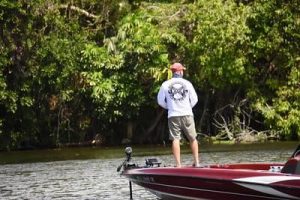
5. Monitor The Water Temperature
The water temperature can vary depending on the time of the year and location. The feeding patterns and activity level of bass are directly affected by the water temperature. The general consensus is to use slower baits in cooler water temperatures and faster and more aggressive lures in warm water. However, knowing the trend in temperature change is more vital than knowing what is the actual temperature.
6. Feeding Time
Bass feed early in the mornings and late evenings when visibility is low and shallower forage is accessible. At this time of the day, bass will be more active and predictable. You can take advantage of their position in shallow areas.
7. Embrace The Wind
Even though it may pose a greater challenge to bass fish during windy days, especially when the wind is blowing over 15 miles per hour, fishing in windy conditions can be very rewarding. Bass will be more receptive on windy days and the bite will pick up. Use faster-moving baits when the wind is blowing as the bass will go for your spinnerbaits and crankbaits.

8. Colorful Lures
Bass likes color. Colorful lures have always been a hit with bass. There are different theories for this attraction to color. Red is the best color for bass. One theory is that bass thinks the lure is injured and the red color is blood. This seems to be a trick to get them to bite.
9. Wounded Prey
Keep your shredded plastic worms. Bass like to pounce on wounded prey and the beat-up and shredded plastic worms look like wounded prey to bass. They will go for it.
10. Make Noise
Make noise on the water by stopping your cast halfway and letting the lure hit the water and skipping a few times. This will make a lot of noise and will get the attention of the bass. This will usually result in a bite.
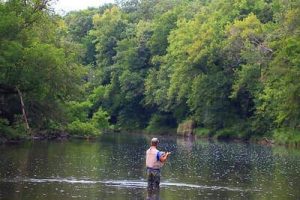
11. Well-Rounded Angler
Try to be a well-rounded angler. Challenge yourself by fishing at new locations and learning and practicing new techniques. Whatever the fishing norms, equipment, techniques, etc. that you use regularly, don’t use them. Try other completely new tools, techniques, and lakes to improve as an angler.
12. Knot Tying
Learn to tie the knot and practice it until it becomes second nature. Learning to tie a knot will save you fishing time and help you take home more fish. If you are interested in knot tying tools, we reviewed the best knot tying tools that you can read.
Types of Bass
There are a number of different types of bass. It will be to your advantage to learn to identify them as each one requires a slightly different approach. Bass can be distinguished by a few features such as jaw length, size of stripes, number, number of spines, and the geographical region they are located in. There are many more types of bass but these are the ones you will most likely encounter.
1. Largemouth Bass
The upper jaw of a largemouth bass extends out past the eye and they feature spiny dorsal fins sandwiched by a deep notch. Largemouth bass, scientifically known as Micropterus salmoides, are one of the most popular and sought-after game fish in North America.
Recognizable by their distinctive large mouths that extend beyond the eyes when the jaw is closed, these predatory fish are native to freshwater habitats across the United States and Canada. Largemouth bass are renowned for their aggressive feeding behavior and powerful strikes, making them a favorite among anglers of all skill levels. They are opportunistic feeders, preying on a wide range of aquatic prey including fish, insects, crustaceans, and even small mammals or birds that venture near the water’s edge.
Largemouth bass are typically found in lakes, ponds, rivers, and reservoirs with ample cover such as submerged vegetation, fallen trees, or rocky structures where they can ambush prey and seek shelter. They are known for their adaptability to various environmental conditions and can thrive in both clear and murky waters.
Largemouth bass are prized for their sportive qualities and are often targeted using a variety of fishing techniques including casting artificial lures, flipping or pitching jigs, and topwater fishing with surface plugs. Due to their popularity among anglers and their significant ecological role as apex predators, largemouth bass are subject to various management and conservation efforts to ensure their sustainability and the health of their habitats.
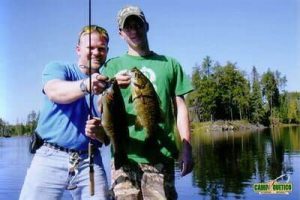
2. Smallmouth Bass
The smallmouth bass’s upper jaw doesn’t extend past the eye. They feature spiny dorsal fins and three dark lines on their cheek. They also have nine to ten spines on the dorsal fin.
Smallmouth bass, scientifically known as Micropterus dolomieu, are highly prized game fish renowned for their aggressive fighting abilities and acrobatic leaps when hooked. Unlike their largemouth counterparts, smallmouth bass have a smaller mouth that extends only to the back of the eye, hence their name. They are native to North America and are found in cool, clear freshwater habitats such as streams, rivers, and lakes with rocky bottoms and moderate currents.
Smallmouth bass are opportunistic predators, feeding on a diverse diet that includes crayfish, insects, small fish, and even small amphibians. They are known for their preference for clear water and are often found near rocky structures, submerged logs, or deep pools where they can ambush prey and seek shelter.
Smallmouth bass are popular among anglers for their challenging behavior and are targeted using a variety of fishing techniques including casting artificial lures such as crankbaits, jigs, and soft plastics, as well as fly fishing with streamers and topwater lures. Due to their recreational importance, smallmouth bass are the focus of conservation efforts aimed at preserving their habitats and maintaining healthy populations for future generations of anglers to enjoy.
3. Florida Bass
The Florida bass is regarded as a subspecies of the largemouth bass. The upper jaw extends past the eye like the largemouth bass and it has nine spines on the dorsal fin.
Florida bass, scientifically known as Micropterus floridanus, is a subspecies of the largemouth bass native to the southeastern United States, particularly Florida. They are highly sought after by anglers for their large size and aggressive feeding behavior.
Florida bass are similar in appearance to other largemouth bass but are known to grow larger on average, with some individuals reaching trophy sizes exceeding 10 pounds or more. They inhabit a variety of freshwater habitats including lakes, rivers, ponds, and reservoirs, preferring areas with abundant aquatic vegetation and ample cover such as submerged logs, fallen trees, and weed beds. Florida bass are opportunistic predators, feeding on a diverse diet of fish, insects, crustaceans, and smaller prey items.
Anglers target Florida bass using a range of techniques including casting artificial lures such as crankbaits, swimbaits, and soft plastics, as well as live bait presentations such as shiners and worms. Due to their popularity among anglers, Florida bass are the focus of conservation efforts aimed at preserving their habitats and genetic diversity to ensure healthy populations for future generations of anglers to enjoy.
4. Redeye Bass
The Redeye bass features small dark spots below the lateral line and a second dorsal that seems to be red. The upper jaw doesn’t extend past the eye.
Redeye bass, scientifically known as Micropterus coosae, is a species of bass native to the southeastern United States, particularly in the Appalachian region. They are known for their distinctive red eyes, which give them their name.
Redeye bass are smaller in size compared to other bass species, typically reaching lengths of around 6 to 12 inches, although larger individuals can occasionally be found. They inhabit clear, cool streams and rivers with rocky bottoms and swift currents, preferring areas with plenty of cover such as boulders, fallen trees, and submerged logs.
Redeye bass are highly prized by anglers for their aggressive strikes and fighting ability, making them a popular sportfish in their native range. Anglers often target redeye bass using light spinning or fly fishing tackle, casting small lures such as spinners, crankbaits, and streamer flies. Redeye bass are considered a sensitive species and are subject to conservation efforts aimed at protecting their native habitats and maintaining healthy populations for future generations to enjoy.
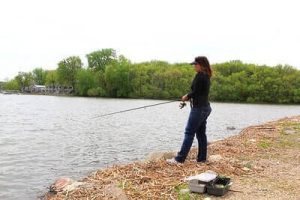
5. Guadalupe Bass
The Guadalupe bass features 10 to 12 dark lateral stripes and its upper jaw does not extend past the eye. The Guadalupe bass (Micropterus treculii) is a species of freshwater bass native to the clear, spring-fed rivers of central Texas, particularly the Guadalupe River, San Antonio River, and Colorado River basins. Named after the Guadalupe River, where it was first discovered, the Guadalupe bass is the official state fish of Texas.
It is a small to medium-sized bass, typically measuring between 6 to 12 inches in length, although larger specimens can be found. Guadalupe bass are easily identified by their olive-green coloration with dark vertical bars along their sides and a distinctive dark blotch at the base of the tail fin. They inhabit clear, flowing waters with rocky bottoms and ample cover, such as submerged rocks, logs, and aquatic vegetation.
Guadalupe bass are known for their voracious appetite and aggressive feeding behavior, making them popular targets for anglers using artificial lures, particularly small crankbaits, spinnerbaits, and topwater plugs. Due to their limited range and susceptibility to habitat degradation and competition from introduced species, Guadalupe bass populations are closely monitored and managed to ensure their conservation and sustainable management for future generations.
6. Alabama Bass
The Alabama bass features lateral blotches and spiny, soft dorsal fins that are connected by a shallow notch. Alabama bass, scientifically known as Micropterus henshalli, is a species of freshwater bass native to the southeastern United States, particularly found in Alabama, Georgia, and Mississippi.
They are closely related to other bass species such as largemouth bass and smallmouth bass but have distinct characteristics that set them apart. Alabama bass typically has a streamlined body shape with a slightly smaller size compared to largemouth bass, averaging around 12 to 15 inches in length. They have a dark olive-green coloration on their backs, fading to a lighter shade on their sides, with a white or cream-colored belly.
Alabama bass are prized by anglers for their strong fighting ability and aggressive feeding behavior, making them a popular sportfish in the region. They are often caught using a variety of artificial lures and live baits, including spinnerbaits, crankbaits, plastic worms, and minnows. However, Alabama bass populations have faced challenges due to habitat loss, pollution, and competition with introduced species, leading to conservation efforts to ensure their long-term survival and sustainability.
7. Shoal Bass
The Shoal bass features dark blotches that fade as it ages. Its upper jaw does not extend beyond the eye. The Shoal bass looks like the Redeye bass without the reddish color.
Shoal bass, scientifically known as Micropterus cataractae, is a species of freshwater bass native to the southeastern United States, particularly found in river systems of Georgia, Alabama, and Florida. Named for their preference for rocky shoals and swift-flowing waters, shoal bass are highly adapted to thrive in these habitats.
They are known for their robust build and powerful fighting ability, making them a favorite target for anglers seeking exciting sportfishing experiences. Shoal bass typically exhibit olive-green or bronze coloration with dark vertical bars along their sides, resembling the appearance of other bass species like smallmouth bass.
However, they can be distinguished by their smaller size and unique habitat preferences. Shoal bass primarily feeds on a variety of aquatic insects, crustaceans, and small fish, and they are often targeted using artificial lures such as crankbaits, spinnerbaits, and topwater plugs. Due to their limited range and specific habitat requirements, shoal bass populations are vulnerable to habitat degradation and habitat fragmentation, necessitating conservation efforts to protect their riverine habitats and ensure their long-term survival.
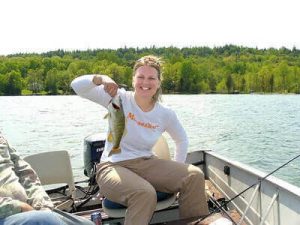
Best Bass Lures
1. Spinnerbait
Spinnerbaits are similar to crankbaits and can work in almost any condition. They are very effective and cover a large amount of water.
Spinnerbaits are versatile and effective lures for bass fishing, renowned for their ability to attract and entice predatory bass species. Consisting of a wire frame with one or more spinning blades, spinnerbaits mimic the movements of baitfish or other prey, making them irresistible to bass.
The spinning blades create flash and vibration in the water, which helps to grab the attention of the bass, even in murky or stained waters where visibility is limited. Anglers can customize spinnerbaits by selecting different blade types, sizes, and colors to match the prevailing fishing conditions and the preferences of the target bass species.
Additionally, spinnerbaits often feature a silicone skirt or other trailers that add lifelike movement and bulk to the lure, further enhancing its appeal. Anglers typically retrieve spinnerbaits at various speeds, ranging from slow and steady retrieves to fast, erratic movements, allowing them to cover different depths and water columns effectively. Spinnerbaits excel in a variety of environments, including shallow flats, weed beds, submerged structures, and open water, making them a go-to choice for bass anglers across the globe.
2. Crankbait
Crankbait is a good bass lure. You can quickly cover a lot of areas using crankbaits. They can be found in a wide range of sizes and colors.
Crankbaits are highly versatile and popular lures among bass anglers, prized for their ability to mimic the appearance and behavior of baitfish, making them irresistible to predatory bass. These lures typically feature a hard plastic body with a diving lip or bill at the front, which allows them to dive to specific depths when retrieved.
Crankbaits come in various sizes, shapes, colors, and diving depths, allowing anglers to cover different water columns and fishing conditions effectively. The wobbling action produced by crankbaits as they are retrieved closely resembles the swimming motion of natural prey, attracting the attention of bass and triggering aggressive strikes.
Anglers can adjust their retrieval speed and depth to target bass holding at various levels in the water column, from shallow flats to deeper drop-offs and structures. Crankbaits are particularly effective when fishing around submerged vegetation, rocky points, submerged logs, and other underwater structures where bass commonly congregate. By experimenting with different crankbait styles and colors, anglers can unlock the potential to catch bass in a wide range of freshwater environments.
3. Soft Plastic Worms
Soft plastic worms are added to hooks and they mimic prey animals. They work to get the bass to hold on to a hook. Soft plastic worms are one of the most effective and versatile lures for bass fishing, renowned for their lifelike appearance and realistic action in the water.
These lures typically consist of soft, flexible plastic bodies molded into the shape of a worm or other natural prey, complete with intricate details like ribbing, ridges, and appendages that mimic the appearance of real baitfish, insects, or other forage.
Soft plastic worms come in various sizes, lengths, colors, and styles, including straight-tail worms, curly-tail worms, ribbon-tail worms, and creature baits, offering anglers a wide range of options to match prevailing fishing conditions and bass preferences.
Anglers commonly rig soft plastic worms Texas-style with a bullet weight to fish them effectively in and around heavy cover like vegetation, brush, and submerged structures, or they can be rigged on a shaky head, Carolina rig, or wacky rig for more finesse presentations in open water. When retrieved, soft plastic worms exhibit a natural undulating action that closely mimics the movement of live prey, enticing bass to strike. Whether fished on the bottom, suspended in the water column, or dragged slowly along the substrate, soft plastic worms consistently produce bites from bass in a variety of freshwater habitats, making them a staple in every bass angler’s tackle box.
4. Swimbait
Swimbaits mimic the swimming motion of small fish thanks to their jointed and hollow bodies. You can find swimbaits in hard and soft versions.
Swimbaits are highly effective lures for targeting bass, known for their realistic appearance and enticing swimming action. These lures typically mimic the profile and movement of baitfish, featuring a lifelike body shape, detailed fins, and often realistic color patterns.
Swimbait designs range from small minnow imitations to larger profiles that replicate trout, shad, or other common prey species. They come in both hard and soft plastic varieties, with soft swimbaits offering a more natural feel and action in the water. Swimbait fishing involves casting the lure and retrieving it at a steady pace, allowing the bait to swim through the water column, and imitating the movements of fleeing baitfish.
Anglers can vary the retrieve speed and cadence to match the activity level of bass and adapt to changing conditions. Swimbait fishing is particularly effective in open water, around submerged structures, or along weed edges where bass are actively hunting for prey. With their realistic appearance and lifelike swimming action, swimbaits excel at enticing strikes from trophy-sized bass, making them a favorite among anglers targeting big fish.
5. Dropshot
The dropshot rig is a versatile and effective technique for targeting bass in various fishing conditions. It involves suspending a soft plastic bait above a weight at the end of the line, creating a natural presentation that entices bass to strike.
The soft plastic bait, typically a finesse worm or minnow imitation, is rigged on a hook tied above the weight, allowing it to float enticingly in the water column. Anglers can adjust the distance between the weight and the bait to target different depths, making the dropshot rig ideal for fishing at various water levels, from shallow flats to deep ledges.
The key to dropshot fishing success lies in finesse and subtlety, as anglers gently shake or twitch the rod tip to impart subtle movement to the bait, mimicking the natural behavior of prey species. This finesse presentation is particularly effective in clear water or when bass are finicky and less aggressive. The dropshot rig excels at enticing bites from both largemouth and smallmouth bass, making it a go-to technique for anglers seeking consistent success on the water.
6. Carolina Rig
The Carolina rig is a popular and effective setup for targeting bass in a variety of fishing environments. It consists of a sliding sinker, a bead, a swivel, a leader line, and a hook. Anglers typically use this rig with soft plastic bait, such as a worm or creature bait.
The sinker is allowed to slide freely on the main line, while the bead and swivel prevent it from sliding to the hook. The leader line, typically ranging from 12 to 36 inches in length, is attached to the swivel and holds the hook and bait. The Carolina rig allows the bait to float above the bottom, creating a natural presentation that entices bass to strike.
Anglers can vary the length of the leader to target bass at different depths, making the Carolina rig versatile for fishing in shallow or deep water. Additionally, the rig’s design reduces the risk of snagging on rocks or vegetation, making it suitable for fishing in areas with heavy cover.
When fishing with a Carolina rig, anglers often employ a slow, methodical retrieve, dragging the bait along the bottom or lifting and dropping it to mimic the movement of natural prey. This technique is highly effective for enticing strikes from both largemouth and smallmouth bass, making the Carolina rig a staple in many bass angler’s arsenals.
7. Wacky Rig
The Wacky rig is a finesse technique widely used by bass anglers to entice strikes from both largemouth and smallmouth bass, particularly in clear or pressured waters. It involves hooking a soft plastic bait, typically a stick worm or senko-style lure, through the middle or slightly off-center, leaving both ends of the bait free to move.
The rigging method creates an enticing wobbling action as the bait falls through the water column, mimicking the movement of injured or distressed prey. Anglers often fish the Wacky rig weightless or with a small split shot or nail weight near the hook to help it sink slowly and maintain a natural presentation.
The Wacky rig is versatile and can be fished in various situations, including around cover such as docks, weed edges, and submerged vegetation. Its subtle action and lifelike presentation make it highly effective for enticing wary bass in clear water or during times of low activity.
Anglers typically employ a slow, twitching retrieve, allowing the bait to sink and flutter enticingly, often triggering aggressive strikes from bass lurking nearby. Overall, the Wacky rig is a proven technique favored by many anglers for its simplicity, versatility, and effectiveness in fooling bass in a variety of conditions.
8. Topwater Frog
The topwater frog lure is a favorite among bass anglers for its ability to elicit explosive strikes, particularly in shallow, weedy areas where bass often lurk. Designed to resemble a frog or other small amphibian, this lure features a weedless design, allowing it to navigate through thick vegetation without getting snagged.
Anglers typically work the topwater frog with a series of sharp twitches and pauses, creating a lifelike swimming action that mimics a frog hopping across the water’s surface. This action, combined with the lure’s realistic appearance, can trigger aggressive strikes from bass hiding in ambush beneath the surface.
The topwater frog is most effective during low-light conditions such as early morning or late evening, as well as on overcast days when bass are more likely to be actively feeding near the surface. Anglers often target areas with submerged vegetation, lily pads, or other forms of cover where bass are known to hide, casting the frog lure into open pockets and along the edges of weed beds.
When a bass strikes, the explosive surface strike is not only exhilarating for the angler but also often results in a memorable battle as the bass attempts to dive back into cover, requiring skillful rod work to land the fish. Overall, the topwater frog lure is a thrilling and effective option for bass anglers looking to target aggressive fish in shallow, weedy environments.
9. Texas Rig
The Texas rig is a versatile and popular setup among bass anglers for its ability to effectively fish various types of cover and structure. It consists of a bullet-shaped weight threaded onto the fishing line followed by a hook, typically an offset worm hook, with a soft plastic bait rigged weedless. This weedless design allows the rig to navigate through dense cover such as weeds, brush, and submerged vegetation without snagging, making it ideal for targeting bass in their natural habitats.
Anglers can customize the Texas rig with a wide range of soft plastic baits, including worms, creature baits, and crawfish imitations, depending on the conditions and the bass’s preferences. The weight can be adjusted to vary the rig’s sinking rate and depth, allowing anglers to effectively fish both shallow and deep water.
To fish the Texas rig, anglers cast it near potential bass-holding areas and allow it to sink to the desired depth before retrieving it with a series of hops and pauses to mimic the natural movement of prey. When a bass strikes, the weedless design of the rig allows for a solid hookset, increasing the angler’s chances of landing the fish. Whether fishing in thick cover or open water, the Texas rig remains a go-to choice for bass anglers seeking versatility, weedless performance, and consistent success on the water.
10. Jigs
Jigs are a staple lure in bass fishing, valued for their versatility and effectiveness in a variety of conditions. Consisting of a weighted head with a hook protruding from it, jigs can be dressed with a multitude of trailer options, including soft plastic creatures, craws, or trailers. Their design allows them to imitate bottom-dwelling prey like crawfish, baitfish, or other forage, making them highly attractive to bass. Jigs come in various weights, shapes, and colors to suit different water depths, bottom compositions, and light conditions.
Anglers can fish jigs through heavy cover, rocky structures, or along drop-offs with equal effectiveness. They are often used in flipping and pitching techniques, where anglers precisely place the jig into target areas near cover and allow it to fall naturally, enticing strikes from lurking bass.
Jigs can also be hopped along the bottom or retrieved with a steady retrieve, making them versatile for different bass fishing techniques. With their lifelike appearance and enticing action, jigs remain a go-to lure for bass anglers looking to catch trophy-sized fish in various freshwater habitats.
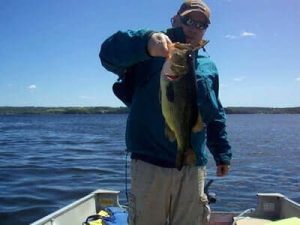
Best Live Bait For Bass
There are many different live bait that you can use for bass fishing. Live bait comes with the problem of storage. Some of the live bait are:
1. Minnows
Schools of minnows are one of the best baits that anglers use to catch bass. Nothing attracts bass more than a school of minnows. Minnows are also used when fishing for a variety of fish.
Minnows are a classic and highly effective bait for bass fishing, renowned for their natural swimming action and irresistible appeal to predatory bass. These small baitfish, often referred to as shiners or fatheads, can be fished live or rigged on hooks in various ways to entice bass strikes.
When rigged on a hook or jighead, live minnows mimic the behavior of injured or fleeing prey, making them enticing targets for bass lurking in cover or along the edges of the structure. Anglers can present minnows under floats or bobbers, allowing them to swim freely at desired depths, or they can be retrieved slowly to imitate injured baitfish struggling near the surface.
Additionally, minnows can be rigged as drop-shot baits or used as trailers on spinnerbaits or swimbaits to add extra lifelike movement and scent attraction. Whether fishing in lakes, ponds, rivers, or reservoirs, minnows remain a go-to bait choice for anglers targeting bass of all sizes and species.
2. Crawfish
Crawfish is also a good bait for attracting and catching bass. Like, many fish, like crawfish are lured by anglers using crawfish.
Crawfish, also known as crayfish or crawdads, are a highly effective bait for bass fishing, particularly in bodies of water where they are a natural part of the bass’s diet. These freshwater crustaceans are abundant in many bass habitats, making them a readily available and enticing food source for bass.
Anglers can use live or imitation crawfish baits to target bass, with both options proving successful in enticing strikes. Live crawfish can be rigged on hooks using various methods, such as Carolina rigs, Texas rigs, or jigheads, to mimic their natural movement and appearance.
Additionally, soft plastic or rubber crawfish imitations, often featuring lifelike appendages and color patterns, can be rigged on hooks or jigheads to mimic the behavior of live crawfish. When presented near rocks, vegetation, or other areas where crawfish are commonly found, these baits can trigger aggressive strikes from bass looking to feed on these tasty crustaceans. Whether fishing in lakes, rivers, or streams, using crawfish as bait can be an effective strategy for enticing bass and increasing angling success.
3. Salamanders
Salamanders is a great bait that attracts bass and anglers use it when bass fishing. Salamanders, both live and artificial imitations, can be effective baits for bass fishing in certain situations. These amphibians are found in various freshwater habitats, often near the edges of ponds, lakes, streams, and marshes, making them accessible prey for bass. Live salamanders, when rigged on hooks or jigheads, can attract bass with their natural movement and scent.
Anglers may also use soft plastic or rubber salamander imitations, which mimic the appearance and behavior of live salamanders, to entice strikes from bass. These artificial baits typically feature lifelike details such as segmented bodies, legs, and tails, making them appear realistic to feeding bass. When presented near structures like rocks, logs, or submerged vegetation where salamanders are commonly found, these baits can effectively draw strikes from bass looking for a meal.
However, it’s essential for anglers to check local regulations regarding the use of live bait, including salamanders, and to ensure the ethical and responsible handling of these creatures when used as bait for bass fishing.
4. Worms
Worms are loved by fish and bass is no exception. it is often used by anglers when targeting bass and most species of fish. Worms are perhaps one of the most versatile and widely used baits for bass fishing. These slender, wriggling creatures are natural prey for bass and can be found in almost any freshwater habitat, making them readily available to anglers.
Both live worms, such as nightcrawlers or red worms, and artificial worm imitations, such as soft plastic worms, are effective in enticing strikes from bass. Live worms can be rigged on hooks using various techniques, such as Texas rigging or wacky rigging, to present them naturally to bass in their feeding zones.
Artificial worm lures come in a variety of sizes, shapes, and colors, allowing anglers to match the hatch or experiment with different presentations to find what works best in specific conditions. Whether fishing in shallow ponds, deep lakes, or flowing rivers, worms are a go-to bait choice for bass anglers seeking to lure these predatory fish with a tempting meal.
5. Leeches
Leeches are a great bait to catch bass and it works well when anglers use it when fishing. Leeches are a natural and effective bait option for bass fishing, particularly in areas where they are abundant. These segmented worms are found in many freshwater habitats, including lakes, ponds, rivers, and streams, making them readily available for anglers.
Bass are naturally attracted to the wriggling movements of leeches, which mimic injured or struggling prey, prompting aggressive strikes. Anglers often rig live leeches on hooks using various methods, such as threading them onto jig heads, Texas rigging, or Carolina rigging, to present them enticingly to bass.
Additionally, artificial leech imitations, made from soft plastic materials, can be used to mimic the appearance and action of live leeches, offering anglers a convenient and long-lasting alternative. Whether fishing in clear or murky waters, leeches can be a reliable bait choice for bass anglers seeking to entice strikes from these predatory fish.
6. Frogs
Frogs work well as bait and anglers often use parts of the frog as bait when bass fishing. Frogs are a classic and versatile bait option for bass fishing, known for their ability to mimic the natural prey of bass and trigger aggressive strikes.
These amphibians are abundant in many freshwater habitats, including ponds, lakes, rivers, and marshes, making them readily available for anglers to use as live bait. Bass are opportunistic predators and often target frogs when they venture into the water, attracted by their lifelike appearance and enticing movements.
Anglers typically rig live frogs on hooks using various methods, such as hooking them through the lips or legs, to present them effectively to bass. Additionally, artificial frog lures, designed to replicate the appearance and action of real frogs, are popular among anglers and can be retrieved using a variety of techniques, including topwater frogging and weedless rigging. Whether using live or artificial frogs, anglers can enjoy exciting bass fishing action while mimicking the natural prey behavior that bass find irresistible.
7. Creek Chubs
Creek chubs are also good bait that anglers use for fishing for bass and other fish. Creek chubs, also known as creek chub suckers, are a popular bait choice among bass anglers due to their availability and effectiveness in enticing predatory strikes.
These small fish are often found in streams, creeks, and rivers throughout North America, making them easily accessible to anglers looking to use live bait for bass fishing. Creek chubs have a natural swimming motion and emit vibrations that attract bass, making them irresistible prey.
Anglers typically rig creek chubs on hooks using methods such as lip hooking or threading the hook through their dorsal fin to present them effectively to bass. Additionally, anglers may use artificial lures designed to mimic the appearance and swimming action of creek chubs, providing a versatile option for enticing bass in a variety of fishing conditions. Whether using live creek chubs or artificial imitations, anglers can capitalize on the natural prey instincts of bass and enjoy productive fishing outings.
The Bottom Line
Bass is one of the most common freshwater fishes in the world. It is also a popular fish for anglers. In this article, we discussed bass fishing tips to help you catch more bass.
It is our hope that after reading this article, you will learn how to catch more bass and become a better bass angler. How to fish a pond is explained in this article which you can read from this link. You can also read black drum fishing tips, weakfish fishing tips, bluefish fishing tips, and pike fishing tips.
